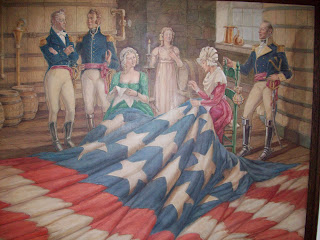 |
| Bombardment of Fort McHenry |
In 1814, Francis Scott Key and his friend John Stuart Skinner were on a mission for President James Madison to secure an exchange of prisoners with the British. While on board the HMS Minden, they overheard British battle plans so were held prisoner and witnessed the British bombardment of Fort McHenry from the deck of the ship. As Key watched the battle, he saw that the storm flag was still flying, but couldn’t tell the result of the battle until sunrise. At dawn, the storm flag had been replaced with the larger flag, inspiring him to write the poem, Defense of Fort McHenry. The poem was later put to the tune of John Stafford Smith's song, The Anacreontic Song. The poem was modified and re-titled The Star Spangled Banner. Congress proclaimed The Star Spangled Banner the US National Anthem in 1931.
In the summer of 1813, Mary Pickersgill, a seamstress who lived in Baltimore, received a request from Major George Armistead, commander of the forces at Fort McHenry, to sew two American flags.
A widow, Mary had established a flag-making business at her home on 44 Queen Street (now 844 E. Pratt Street). She learned flag-making from her mother, Rebecca Young, who made ensigns, garrison flags, and continental standards during and after the Revolutionary War.
Major Armistead’s instructions were to make two flags, one of them “so large that the British will have no difficulty seeing it from a distance.”
 |
| Painting in the Mary Pickersgill Museum |
For seven weeks, Mary worked on two flags along with Caroline, her thirteen-year-old daughter; her nieces, Eliza and Margaret Young (thirteen and fifteen, respectively); and Grace Wisher, a thirteen-year-old African American indentured servant. They pieced together strips of wool bunting that were twelve to eighteen inches wide. They used over four-hundred yards of fabric, until each stripe was two feet wide. There were eight red and seven white stripes. Each of the fifteen stars measured two feet from tip to tip. One flag was a seventeen by twenty-foot storm flag for use in bad weather. The other, the one that inspired Francis Scott Key to compose The Star Spangled Banner, was a thirty by forty-two foot garrison flag.
Lyrics of the Star Spangled Banner
Oh, say can you see by the dawn's early light
What so proudly we hailed at the twilight's last gleaming?
Whose broad stripes and bright stars thru the perilous fight,
O'er the ramparts we watched were so gallantly streaming?
And the rocket's red glare, the bombs bursting in air,
Gave proof through the night that our flag was still there.
Oh, say does that star-spangled banner yet wave
O'er the land of the free and the home of the brave?
On the shore, dimly seen through the mists of the deep,
Where the foe's haughty host in dread silence reposes,
What is that which the breeze, o'er the towering steep,
As it fitfully blows, half conceals, half discloses?
Now it catches the gleam of the morning's first beam,
In full glory reflected now shines in the stream:
'Tis the star-spangled banner! Oh long may it wave
O'er the land of the free and the home of the brave!
And where is that band who so vauntingly swore
That the havoc of war and the battle's confusion,
A home and a country should leave us no more!
Their blood has washed out their foul footsteps' pollution.
No refuge could save the hireling and slave
From the terror of flight, or the gloom of the grave:
And the star-spangled banner in triumph doth wave
O'er the land of the free and the home of the brave!
Oh! thus be it ever, when freemen shall stand
Between their loved home and the war's desolation!
Blest with victory and peace, may the heav'n rescued land
Praise the Power that hath made and preserved us a nation.
Then conquer we must, when our cause it is just,
And this be our motto: "In God is our trust."
And the star-spangled banner in triumph shall wave
O'er the land of the free and the home of the brave!
What so proudly we hailed at the twilight's last gleaming?
Whose broad stripes and bright stars thru the perilous fight,
O'er the ramparts we watched were so gallantly streaming?
And the rocket's red glare, the bombs bursting in air,
Gave proof through the night that our flag was still there.
Oh, say does that star-spangled banner yet wave
O'er the land of the free and the home of the brave?
On the shore, dimly seen through the mists of the deep,
Where the foe's haughty host in dread silence reposes,
What is that which the breeze, o'er the towering steep,
As it fitfully blows, half conceals, half discloses?
Now it catches the gleam of the morning's first beam,
In full glory reflected now shines in the stream:
'Tis the star-spangled banner! Oh long may it wave
O'er the land of the free and the home of the brave!
And where is that band who so vauntingly swore
That the havoc of war and the battle's confusion,
A home and a country should leave us no more!
Their blood has washed out their foul footsteps' pollution.
No refuge could save the hireling and slave
From the terror of flight, or the gloom of the grave:
And the star-spangled banner in triumph doth wave
O'er the land of the free and the home of the brave!
Oh! thus be it ever, when freemen shall stand
Between their loved home and the war's desolation!
Blest with victory and peace, may the heav'n rescued land
Praise the Power that hath made and preserved us a nation.
Then conquer we must, when our cause it is just,
And this be our motto: "In God is our trust."
And the star-spangled banner in triumph shall wave
O'er the land of the free and the home of the brave!














